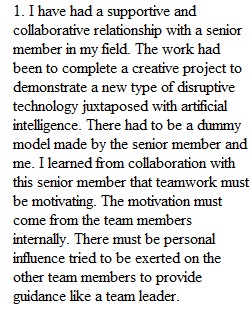


Q What does it mean to collaborate effectively? How can we collaborate well without stifling creativity due to too much control over the process? An improvisational approach similar to a skilled jazz ensemble is an effective model of group flow for organizations and groups. Understanding organizational context sheds additional light on the creativity in the workplace. This activity aligns with module outcome 1. Prepare for your discussion by reviewing the required readings and videos described in each discussion topic. Respond to one of the following questions. 1. If you have had a supportive, collaborative relationship with a senior member of your field or a professor in your major field of study, what did you learn about collaboration from this person? If you have not experienced this sort of supportive, collaborative relationship, what do you think would be gained in your career path if you formed one? 2. In the collaborative exercises you have completed so far for our class, did you ever achieve a state of group flow, as described on page 245 of Explaining Creativity? Which of the 10 characteristics have you experienced so far in your group work? How might you work toward incorporating more of these in the remaining collaborative assignments? 3. If you have experienced group collaboration without central guidance as demonstrated by Keith Sawyer in "The Creative Power of Collaboration" video, describe the experience in detail. Compare and contrast your experience with the ideas and collaborative spirit that was portrayed in the video. 4. If you have worked in a large organization (corporate or nonprofit) think about the procedures and practices you were taught. Where did these come from? Which ones did you have to learn on your own? Describe the procedures and practices that were written down in an official book of procedures or employee handbook. How do these procedures and practices enhance or dissuade effective collaboration with colleagues?
View Related Questions